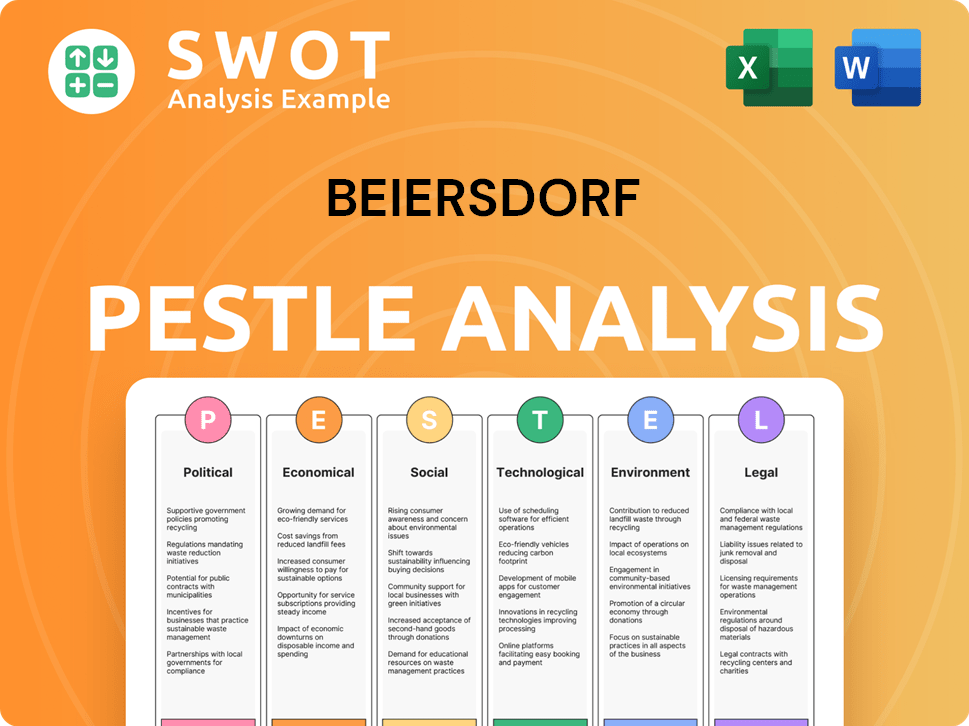Beiersdorf Bundle
How Did a Hamburg Pharmacy Become a Global Skincare Giant?
Discover the fascinating Beiersdorf SWOT Analysis and journey of Beiersdorf, a company that began in 1882 in Hamburg, Germany, and revolutionized the cosmetics industry. From its early days manufacturing pharmaceutical plasters, Beiersdorf's innovation with Eucerit in 1902 transformed its trajectory. This pivotal moment paved the way for iconic products like Nivea Creme and its rise as a global leader in skin care brands.

This brief history of Beiersdorf explores its remarkable evolution, highlighting key milestones and its impact on the beauty industry. Learn about the early Beiersdorf products and how the company adapted to changing consumer needs, solidifying its global presence. Understand the strategic decisions that shaped Beiersdorf's success, from its founding by Paul C. Beiersdorf to its current status as a leading player in the cosmetics industry, with a diverse portfolio of skincare brands.
What is the Beiersdorf Founding Story?
The story of the Beiersdorf company began in Hamburg, Germany, on March 28, 1882. This marked the founding of the company by Paul C. Beiersdorf, a pharmacist, who initially focused on medical plasters.
Beiersdorf identified a need for better wound care solutions. His innovation, a new type of gutta-percha plaster, offered improved adhesive properties and skin compatibility, addressing a crucial problem in medical practices at the time. This early focus set the stage for the company's future in skincare and personal care.
The initial business model centered on directly selling these pharmaceutical plasters to pharmacies and medical institutions. Beiersdorf's expertise as a pharmacist provided him with direct insight into the needs of the medical community. This understanding was key to developing specialized products.
Paul C. Beiersdorf founded the company in 1882 in Hamburg, Germany, initially focusing on medical plasters.
- Beiersdorf's innovation was a gutta-percha plaster, known for its superior adhesive properties.
- The company's early business model involved direct sales to pharmacies and medical institutions.
- In 1890, Oscar Troplowitz, also a pharmacist, acquired the company from Paul C. Beiersdorf.
- Troplowitz expanded the product range beyond plasters, setting the foundation for the company's growth in the skin care brands and cosmetics industry.
In 1890, Paul C. Beiersdorf sold his company to Oscar Troplowitz, another pharmacist. Troplowitz saw the potential in Beiersdorf's innovations and expanded the product range beyond plasters. This strategic move transformed the company from a specialized pharmaceutical producer into a broader personal care enterprise, setting the stage for its future success. The company's evolution reflects a keen understanding of market needs and a commitment to innovation, which has been a cornerstone of its enduring presence in the beauty industry.
Beiersdorf SWOT Analysis
- Complete SWOT Breakdown
- Fully Customizable
- Editable in Excel & Word
- Professional Formatting
- Investor-Ready Format

What Drove the Early Growth of Beiersdorf?
Under the leadership of Oscar Troplowitz, the Beiersdorf company experienced substantial early growth and expansion. This period was marked by groundbreaking innovations and strategic market entries. The company's evolution transformed it from a local pharmaceutical entity into a significant player in the global personal care market. This chapter explores the key milestones that shaped Beiersdorf's history.
A pivotal moment in the Beiersdorf history was the 1902 launch of Eucerin. This innovative emulsifier enabled the creation of stable water-in-oil emulsions. This technological advancement was crucial for developing new skincare products. The innovation directly led to the creation of iconic Nivea Creme.
The launch of Nivea Creme in 1911 marked a significant entry into the cosmetics industry for Beiersdorf. Nivea Creme was revolutionary, offering a stable, pleasant-smelling, and affordable skincare product. Its success quickly established Beiersdorf as a major player in the skincare market. This was a key moment in the Nivea history.
Early product launches diversified Beiersdorf's portfolio. Labello lip care, introduced in 1909, and Hansaplast plasters in 1922, expanded the product range. These additions moved the company beyond its initial pharmaceutical plasters. This diversification was key to its early success in the cosmetics industry.
International expansion was a strategic focus for Beiersdorf early on. Nivea Creme gained traction in various European markets. By the 1920s, the company had subsidiaries and production facilities in the United Kingdom, the United States, and Denmark. This global presence helped establish Beiersdorf as a leading brand.
After Oscar Troplowitz's death in 1918, the company transitioned into a stock corporation. This move ensured continued growth and professional management. The company expanded its team beyond its founders, with dedicated research and development teams. This change was critical for long-term sustainability.
Beiersdorf's growth was characterized by innovation, brand building, and internationalization. These strategies shaped its trajectory from a local pharmaceutical company to a global personal care enterprise. The company's focus on innovation continues to drive its success, as highlighted in the Competitors Landscape of Beiersdorf. This approach has solidified its position in the skin care brands market.
Beiersdorf PESTLE Analysis
- Covers All 6 PESTLE Categories
- No Research Needed – Save Hours of Work
- Built by Experts, Trusted by Consultants
- Instant Download, Ready to Use
- 100% Editable, Fully Customizable

What are the key Milestones in Beiersdorf history?
The Beiersdorf history is marked by significant achievements, establishing itself as a key player in the cosmetics industry. From its founding in Hamburg, Germany, the Beiersdorf company has consistently expanded its reach and influence, setting new standards in the skin care brands sector.
| Year | Milestone |
|---|---|
| 1882 | Paul Beiersdorf obtains a patent for a medical plaster, marking the inception of the Beiersdorf company. |
| 1911 | The introduction of Nivea Creme revolutionizes skincare, becoming a global icon. |
| 1950 | Eucerin pH5 is launched, catering to sensitive skin needs. |
| 1990 | Acquisition of La Prairie expands the company's presence in the prestige skincare market. |
| 2023 | Beiersdorf reported sales of approximately €8.79 billion, a nominal increase of 10.8% compared to the previous year. |
Beiersdorf's commitment to innovation is evident in its product development and scientific advancements. The company has consistently invested in research to create effective and consumer-focused solutions, driving its evolution in skincare.
The introduction of Nivea Creme in 1911 was a groundbreaking innovation, establishing a global standard for skincare and setting the stage for future product developments. This product quickly became a staple in households worldwide.
The development of Eucerin pH5 in 1950 marked a significant advancement, specifically addressing the needs of sensitive skin. This innovation highlighted the company's focus on scientific research and consumer needs.
Beiersdorf has secured numerous patents for its proprietary formulations and technologies, including those related to UV filters. These innovations have enhanced the effectiveness and safety of skincare products.
The company's research into skin regeneration has led to advanced skincare solutions. These advancements have improved product efficacy and addressed a wider range of consumer needs.
Collaborations with dermatologists, particularly for Eucerin, have solidified Beiersdorf's scientific credentials. These partnerships have enhanced product development and credibility.
The acquisition of La Prairie in 1990 marked an entry into the prestige skincare market. This strategic move expanded the company's portfolio and global presence.
Despite its successes, Beiersdorf has faced several challenges throughout its history. Economic downturns and intense competition have necessitated strategic adaptations and continuous innovation, impacting the Beiersdorf company timeline.
Economic downturns, such as the Great Depression, significantly impacted international operations and supply chains. These challenges required agile responses to maintain market presence.
Intense competition from other multinational consumer goods companies has necessitated continuous innovation and strategic marketing efforts. Maintaining a competitive edge is crucial.
Product failures, though less common for its core brands, have occurred, requiring agile responses and product reformulations. These instances underscore the importance of market research.
Managing a diverse portfolio of brands with distinct market positions and target audiences has presented organizational complexities. Streamlining operations is essential for efficiency.
World Wars led to the loss of foreign assets and disruptions in supply chains, impacting the company's global operations. These events required significant adaptation.
Fluctuations in market trends and consumer preferences pose ongoing challenges, requiring constant monitoring and strategic adjustments. Staying ahead of the curve is vital.
For a deeper understanding of the strategies employed by Beiersdorf, consider exploring the Marketing Strategy of Beiersdorf.
Beiersdorf Business Model Canvas
- Complete 9-Block Business Model Canvas
- Effortlessly Communicate Your Business Strategy
- Investor-Ready BMC Format
- 100% Editable and Customizable
- Clear and Structured Layout

What is the Timeline of Key Events for Beiersdorf?
The Beiersdorf company, known for its iconic skincare brands, has a rich history. From its origins in Hamburg, Germany, to its global presence today, the company has consistently adapted and innovated within the cosmetics industry. This evolution reflects its commitment to skincare and its ability to meet changing consumer needs.
| Year | Key Event |
|---|---|
| 1882 | Paul Beiersdorf founded the company in Hamburg, Germany, establishing a pharmaceutical business. |
| 1890 | Dr. Oscar Troplowitz took over and developed the first modern plaster. |
| 1900 | The company patented Eucerin, an emulsifier, marking a significant step in skincare. |
| 1911 | Nivea Cream, one of the earliest and most successful skincare products, was launched. |
| 1922 | The company expanded internationally, establishing a presence in various countries. |
| 1989 | The company was listed on the stock exchange. |
| 2001 | The company acquired the La Prairie brand. |
| 2023 | Beiersdorf reported a significant increase in sales, driven by its skincare brands. |
Beiersdorf continues to invest heavily in research and development. This focus ensures that its products remain at the forefront of skincare technology. The company's commitment to innovation drives the creation of new products.
The company is expanding its presence in emerging markets. This growth strategy includes tailored product offerings. This expansion is expected to boost overall revenue.
The company is increasingly focused on sustainability. This includes eco-friendly packaging and sustainable sourcing. These initiatives align with consumer demand for environmentally responsible products.
Beiersdorf is investing in digital marketing and e-commerce. This strategy enhances its ability to reach consumers directly. Digital channels are becoming increasingly important.
Beiersdorf Porter's Five Forces Analysis
- Covers All 5 Competitive Forces in Detail
- Structured for Consultants, Students, and Founders
- 100% Editable in Microsoft Word & Excel
- Instant Digital Download – Use Immediately
- Compatible with Mac & PC – Fully Unlocked

Related Blogs
- What is Competitive Landscape of Beiersdorf Company?
- What is Growth Strategy and Future Prospects of Beiersdorf Company?
- How Does Beiersdorf Company Work?
- What is Sales and Marketing Strategy of Beiersdorf Company?
- What is Brief History of Beiersdorf Company?
- Who Owns Beiersdorf Company?
- What is Customer Demographics and Target Market of Beiersdorf Company?
Disclaimer
All information, articles, and product details provided on this website are for general informational and educational purposes only. We do not claim any ownership over, nor do we intend to infringe upon, any trademarks, copyrights, logos, brand names, or other intellectual property mentioned or depicted on this site. Such intellectual property remains the property of its respective owners, and any references here are made solely for identification or informational purposes, without implying any affiliation, endorsement, or partnership.
We make no representations or warranties, express or implied, regarding the accuracy, completeness, or suitability of any content or products presented. Nothing on this website should be construed as legal, tax, investment, financial, medical, or other professional advice. In addition, no part of this site—including articles or product references—constitutes a solicitation, recommendation, endorsement, advertisement, or offer to buy or sell any securities, franchises, or other financial instruments, particularly in jurisdictions where such activity would be unlawful.
All content is of a general nature and may not address the specific circumstances of any individual or entity. It is not a substitute for professional advice or services. Any actions you take based on the information provided here are strictly at your own risk. You accept full responsibility for any decisions or outcomes arising from your use of this website and agree to release us from any liability in connection with your use of, or reliance upon, the content or products found herein.